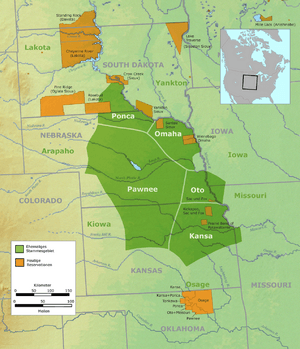Moses Merrill Mission facts for kids
Quick facts for kids |
|
|
Moses Merrill Mission and Oto Village
|
|
| Location | Bellevue, Nebraska |
|---|---|
| Built | 1835 |
| NRHP reference No. | 72000757 |
| Added to NRHP | March 16, 1972 |
The Moses Merrill Mission, also known as the Oto Mission, was an important place in Nebraska's history. It was located about eight miles west of Bellevue, Nebraska. This mission was built and lived in by Moses and Eliza Wilcox Merrill. They were the first missionaries to live in Nebraska.
The first building was part of a group of facilities built in 1835. This was when the United States Government moved the Otoe people about eight miles southwest of Bellevue. Moses Merrill wanted to teach the local Otoe tribe about Christianity. He learned their language and translated parts of the Bible and some hymns into Otoe.
The first log cabin at the mission burned down and had to be replaced. By 1835, the Merrills had built a new building that served as both a school and a church. Moses Merrill died in 1840 from a sickness called tuberculosis. After his death, the Otoe people left the mission and moved their village. His wife, Eliza Merrill, returned to the East with their son. Other settlers used the mission cabin until the 1860s.
Today, the only parts left of the second, larger mission building are its original chimney and some cottonwood trees. Eliza Merrill planted these trees. As of July 2016, the last remaining cottonwood tree was taken down. The site was added to the National Register of Historic Places in 1972. This means it's a special place recognized for its history. The state of Nebraska has also placed a historical marker near where the Oto Mission used to be.
Contents
The Merrills' Journey to Nebraska
The Reverend Moses Merrill came from Sedgwick, Maine. His father, Daniel, was also a minister. Moses traveled to the Michigan Territory. There, he met Eliza Wilcox from Albany, New York, through friends. They got married and trained to become missionaries for the Baptist Church.
In 1833, Moses and Eliza arrived in Bellevue, Nebraska. The Indian agent offered them a place to stay in an old trading post called Fontenelle's Post. This post was part of the buildings used by the Bellevue Indian Agency. Moses Merrill immediately started learning the Otoe language. Later, he translated parts of the Bible and some hymns into Otoe.
Building the Mission and School
The US Government moved the Otoe people to a new location southwest of Bellevue. This new spot was near where the Platte River flows into another river. The Merrills followed the Otoe to stay with them. At first, they used a log cabin that the government provided.
In 1835, the Merrills quickly set up a school and a church for the Otoe tribe. The Otoe's main village and cemetery were only a quarter of a mile southeast of the mission.
About a year after they moved, the Merrills' first mission cabin burned down. They built a larger house to replace it. This new building also served as their school. Soon after, Moses Merrill encouraged the Otoe to move their village closer to his mission. The Otoe had lived near Yutan for a long time. The Merrills then ran a school for Otoe children and held church services at the new mission.
Moses Merrill's Important Work
Moses Merrill made a lasting impact by translating the Bible and other writings into the Otoe language. The missionary work was very hard. The Merrills tried to protect the Otoe people from traders who were not fair and from settlers who were not understanding. They also dealt with different groups of Native Americans.
Moses Merrill traveled often because the Otoe territory stretched all the way to the Elkhorn River. In 1839, he became sick with tuberculosis. He died from this illness in 1840. After his death, the Otoe people left the mission and moved to a new village.
Eliza Merrill left Nebraska soon after her husband died. She returned to Albany, New York, with their son. There, she started a home for children who didn't have parents. Other settlers continued to use the old mission building for church services even after the 1860s.
What the Mission Looked Like
The first mission building was a simple shack made from local wood. The second mission building was built after the first one burned down in 1836 or 1837. This new building had a schoolroom for Otoe children. It also had living areas, including two bedrooms on the second floor. A porch ran across the front of the building, facing south. It is believed that Eliza Merrill planted at least three of the huge cottonwood trees that stood at the site. These trees were very large, with trunks 25 to 30 feet around.
The building was made from poplar logs. These logs were squared and carefully fitted together at the corners. Lime plaster was poured between the log walls and the thin wooden boards on the inside. A large chimney was built in the center of the building. It was made of local limestone and plastered with lime that was "almost as hard as the stone itself." The chimney was 25 feet tall with a base that was five feet square. Today, only the chimney and the cottonwood trees remain at the site.
Honoring the Mission Site
- The Moses Merrill Mission site is listed on the National Register of Historic Places. This means it is recognized as an important historical place.
- Both Moses and Eliza Merrill kept diaries during this time. Moses's diary covers the period from November 29, 1832, to September 14, 1839. Eliza's diary covers May 20, 1832, to July 13, 1841. These diaries, along with their letters and other papers, are kept by the Nebraska State Historical Society.
See also


